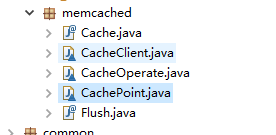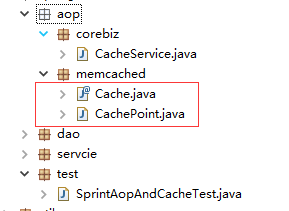一般情况下,java程序取一条数据是直接从数据库中去取,当数据库达到一定的连接数时,就会处于排队等待状态,某些在一定时间内不会发生变化的数据,完全没必要每次都从数据库中去取,使用spring-aop + memcached 技术,取数据时,先从缓存中去取,缓存中如果存在,直接返回结果,无需访问数据库;如果缓存中不存在,再访问数据库,并把这条数据保存到缓存中,当程序下次再访问时,就可以取到缓存中的值了。这样不但可以大大减少访问数据库的次数(减轻数据的负担),而且可以提高程序的运行效率,因为memecached 是采用key - value 方法存取数据的。但是缓存如果使用不当,不但容易造成数据混乱,而且容易导致意想不到的bug。当然除了使用spring-aop 实现缓存技术之外,也可以使用aspectj 实现。
使用memcached时特别需要注意的是:
1.当某条数据发生变化时,一定要更新cache中的这条记录;
2.设置key时一定要唯一,一般是通过prefix + uuid 保证唯一,prefix一般使用数据库的表名;
3.合理设置缓存的时间,即有效期。
下面来介绍一下spring-aop + memcached 技术的简单实现:
1.定义注解类 @Cache
@Target(ElementType.METHOD) @Retention(RetentionPolicy.RUNTIME) public @interface Cache { /** * key的前缀 * @return */ String prefix(); /** * 指定哪个参数值做Key,与cacheKey两者选一,如果都有输入,默认使用indexKey * @return */ int indexKey() default 0; /** * 缓存有效期 1000*60*60*2=2小时,下面代码暂时没有实现此功能 * @return */ long expiration() default 1000 * 60 * 60 * 2; }
2.定义切入点类 CachePoint,这个类一定要与上面的注解类在同一包目录下
@Component @Aspect public class CachePoint { @Autowired private CacheService cacheService; /** * @Pointcut("@annotation(Cache)") 表示定义切入点所有带有@Cache注解的方法 */ @Pointcut("@annotation(Cache)") public void queryCache(){ System.out.println("此输出将不会执行..."); } @Around("queryCache()") public Object getByCache(ProceedingJoinPoint pjp) throws Throwable { // 1.查询缓存的值 Object obj = cacheService.getKey("test_1000123456"); // 2.如果缓存中不存在,则查询mysql数据库 if (null==obj) { obj = pjp.proceed(); // 3.将obj的值写入缓存 cacheService.setKey("test_1000123456", obj); } return obj; } }
3.编写memcached 的业务类
@Component("cacheService")
public class CacheService {
/**
* 读取缓存的方法
* @param key
* @return
*/
public Object getKey(String key) {
System.out.println("query from memcached");
return null;
}
/**
* 写入缓存的方法
* @param key
* @param obj
*/
public void setKey(String key, Object obj) {
}
/**
* 删除缓存的方法
* @param key
*/
public void delete(String key) {
}
}
4.Dao 的实现层添加注解
@Component("testDao")
public class TestDaoImpl implements TestDao {
/**
* 此处将使用 prefix + indexKey 作为缓存的key,即 test_ + uuid
*/
@Cache(indexKey=1, prefix="test_")
@Override
public String query(String uuid) {
System.out.println("query from mysql");
return "caoxiaobo";
}
}
配置文件spring-aop.xml:
<?xml version="1.0" encoding="UTF-8"?> <beans xmlns="http://www.springframework.org/schema/beans" xmlns:aop="http://www.springframework.org/schema/aop" xmlns:xsi="http://www.w3.org/2001/XMLSchema-instance" xmlns:p="http://www.springframework.org/schema/p" xmlns:context="http://www.springframework.org/schema/context" xmlns:mvc="http://www.springframework.org/schema/mvc" xsi:schemaLocation="http://www.springframework.org/schema/beans http://www.springframework.org/schema/beans/spring-beans-3.1.xsd http://www.springframework.org/schema/aop http://www.springframework.org/schema/aop/spring-aop-4.3.xsd http://www.springframework.org/schema/context http://www.springframework.org/schema/context/spring-context-3.1.xsd http://www.springframework.org/schema/mvc http://www.springframework.org/schema/mvc/spring-mvc-4.0.xsd"> <!-- 自动扫描 --> <context:component-scan base-package="com.spring.*" /> <!-- 开启注入注解扫描 --> <context:annotation-config/> <aop:aspectj-autoproxy/> </beans>
测试:
@RunWith(SpringJUnit4ClassRunner.class) @ContextConfiguration(locations = { "classpath:spring-aop.xml" }) public class SprintAopAndCacheTest { @Autowired TestService testService; @Test public void test() { String name = testService.query("1000123456"); System.out.println(name); } }
在执行测试代码的时候,除了第一次执行会输出 “query from mysql” 之外,后面都不会执行这条输出语句。
上述代码仅仅只是一个很简单的spring-aop的示例,下面继续修改CachePoint类,来实现 spring-aop + memcached

@Component("cachePoint")
@Aspect
class CachePoint {
/**
* @Pointcut("@annotation(Cache)") 表示定义切入点所有带有@Cache注解的方法
*/
@Pointcut("@annotation(com.rose.aop.memcached.Cache)")
public void cachePointcut(){
System.out.println("此输出将不会执行...");
}
@Around(value="cachePointcut()")
public Object cacheAround(ProceedingJoinPoint pjp) {
return invoke(pjp);
}
/**
* 1.查询
* 2.
* 3.
* 4.删除
* 5.删除并返回
* @return
* @throws Throwable
*/
private Object invoke (ProceedingJoinPoint pjp) {
Object object = null;
Cache cache = this.getCache(pjp);
int operation = cache.operation();
switch (operation) {
case 1:
object = query(pjp, cache);
break;
// 待实现
case 2:
break;
// 待实现
case 3:
break;
case 4:
delete1(pjp, cache);
break;
case 5:
object = delete(pjp, cache);
break;
default:
break;
}
return object;
}
/**
* 通过反射获取cache的对象,包含很多参数
* @param pjp
* Object[] getArgs:返回目标方法的参数
* Signature getSignature:返回目标方法的签名
* Object getTarget:返回被织入增强处理的目标对象
* Object getThis:返回AOP框架为目标对象生成的代理对象
* @return
*/
private Cache getCache(ProceedingJoinPoint pjp) {
Cache cache = null;
try {
Signature signature = pjp.getSignature();
Class<?> clazz = Class.forName(pjp.getTarget().getClass().getName());
Class<?>[] paramTypes = ((MethodSignature) pjp.getSignature()).getMethod().getParameterTypes();
Method method = clazz.getMethod(signature.getName(), paramTypes);
Annotation annotation = method.getAnnotation(Cache.class);
cache = (Cache) annotation;
} catch (ClassNotFoundException e) {
// TODO Auto-generated catch block
e.printStackTrace();
} catch (NoSuchMethodException e) {
// TODO Auto-generated catch block
e.printStackTrace();
} catch (SecurityException e) {
// TODO Auto-generated catch block
e.printStackTrace();
}
return cache;
}
private Object query(ProceedingJoinPoint pjp, Cache cache) {
// 方法传入的参数
Object[] objs = pjp.getArgs();
int indexKey = cache.indexKey();
String prefix = cache.prefix();
String key = prefix + objs[indexKey-1];
System.out.println("key : " + key);
// 1.查询缓存的值
Object obj = CacheOperate.getKey(key);
// 2.如果缓存中不存在,则查询mysql数据库
if (null==obj) {
try {
obj = pjp.proceed();
// 3.将obj的值写入缓存
CacheOperate.setKey(key, obj);
} catch (Throwable e) {
// TODO Auto-generated catch block
e.printStackTrace();
}
}
return obj;
}
private Object delete(ProceedingJoinPoint pjp, Cache cache) {
System.out.println("删除缓存操作");
Object[] objs = pjp.getArgs();
int indexKey = cache.indexKey();
String prefix = cache.prefix();
String key = prefix + objs[indexKey-1];
CacheOperate.delete(key);
try {
return pjp.proceed();
} catch (Throwable e) {
// TODO Auto-generated catch block
e.printStackTrace();
}
return null;
}
private void delete1(ProceedingJoinPoint pjp, Cache cache) {
delete(pjp, cache);
}
}
class CacheOperate { private static CacheClient cacheClient = CacheClient.getInstance(); /** * 读取缓存的方法 * @param key * @return */ public static Object getKey(String key) { System.out.println("查询缓存"); return cacheClient.get(key); } /** * 写入缓存的方法 * @param key * @param obj */ public static void setKey(String key, Object value) { cacheClient.set(key, value); } /** * 删除缓存的方法 * @param key */ public static void delete(String key) { cacheClient.delete(key); } }
memcached的连接及初始化 及增、删、改、查
class CacheClient { private CacheClient() {} private static CacheClient cacheClient = null; private static MemCachedClient client = new MemCachedClient(); // 服务器列表和其权重 private static String[] servers = { "127.0.0.1:11211" }; /**
* 项目启动时(类加载的过程中)连接及初始化
*/ static { // 获取soket 连接池的实例对象 SockIOPool pool = SockIOPool.getInstance(); // 设置服务器信息 pool.setServers(servers); pool.setFailover(true); //设置初始连接数、最小和最大连接数以及最大处理时间 pool.setInitConn(10); pool.setMinConn(5); pool.setMaxConn(250); // 设置主线程的睡眠时间 pool.setMaintSleep(30); // 设置TCP的参数和连接超时 pool.setNagle(false); pool.setSocketTO(3000); pool.setAliveCheck(true); // 初始化连接池 pool.initialize(); } public static CacheClient getInstance() { if (null==cacheClient) { cacheClient = new CacheClient(); } return cacheClient; } public Object get(String key) { return client.get(key); } public boolean set(String key, Object value) { return client.set(key, value); } public boolean set(String key, Object value, int expiry) { Calendar nowTime = Calendar.getInstance(); nowTime.add(Calendar.SECOND, expiry); return client.set(key, value, nowTime.getTime()); } public boolean add(String key, Object value) { return client.add(key, value); } public boolean add(String key, Object value, int expiry) { Calendar nowTime = Calendar.getInstance(); nowTime.add(Calendar.SECOND, expiry); return client.add(key, value, expiry); } public boolean replace(String key, Object value) { return client.replace(key, value); } public boolean replace(String key, Object value, int expiry) { Calendar nowTime = Calendar.getInstance(); nowTime.add(Calendar.SECOND, expiry); return client.replace(key, value, expiry); } public boolean delete(String key) { return client.delete(key); } public boolean flushAll() { return client.flushAll(); } }
